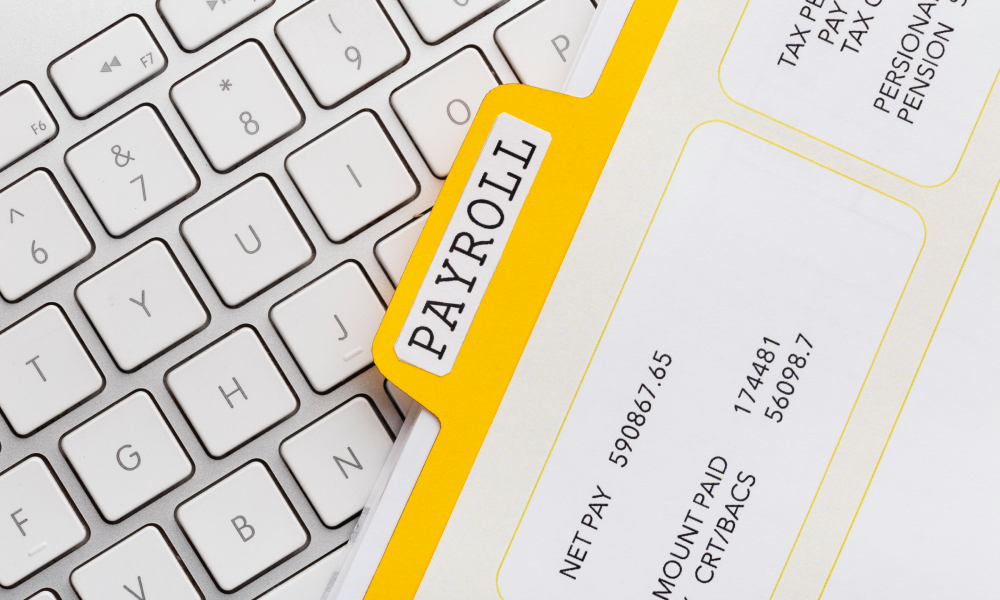If you run a field service business, whether that’s plumbing, HVAC, electrical, landscaping, property maintenance, or security, payroll probably isn’t your favorite task — but it’s one you can’t afford to get wrong.
Paying your team correctly and on time isn’t just about keeping people happy. It also keeps you compliant with HMRC in the UK or Revenue in Ireland, helps you avoid costly mistakes, and saves a lot of time on back-and-forth admin.
When payroll slips through the cracks, things can get messy. Fines and penalties are bad enough, but frustrated staff won’t always stick around. On the other hand, when everything runs smoothly, payroll becomes one of those behind-the-scenes processes you can actually trust.
That’s why more and more service businesses are switching to payroll software. A good system reduces paperwork, keeps you in line with the latest rules, and connects with the tools you already use. Less time chasing payslips means more time focusing on the work that grows your business.
In this guide, we’ll break down what to look for in payroll software — and how to choose a solution that actually fits the way field service teams work.
- Why Payroll Matters More Than You Think
- Payroll Basics for UK & Irish Field Service Businesses
- What to Look for in Payroll Software
- Free vs Paid Payroll Tools
- Best Payroll Software for Small Field Team
- Best Payroll Software for Growing SMEs
- Enterprise-Grade Options
- Integration with Fieldmotion
- How to Choose the Right Payroll System
- Implementation Guide
- Common Pitfalls and How to Avoid Them
- ROI: How Payroll Software Pays for Itself
- Next Steps: Optimising Beyond Payroll
- Payroll as a Growth Tool
Fieldmotion Brochure
See how Fieldmotion helps field service teams manage jobs, schedule staff, create invoices, and communicate with customers — all from one easy-to-use system.
1. Why Payroll Matters More Than You Think
Payroll often gets treated as an admin task — something that has to be done, but never really given much thought. But in field service businesses, where teams are often out on the road, payroll plays a bigger role than you might realise.
Here’s why it matters:
Compliance risks
In the UK, employers are required to submit Real Time Information (RTI) every time staff are paid. In Ireland, Revenue expects every payroll to be submitted through PAYE Modernisation. Get it wrong or submit late, and you could face fines.
Pensions and auto-enrolment
Whether you’re operating in the UK or Ireland, employers must enrol eligible workers into a pension scheme. Your payroll system needs to calculate contributions automatically to stay compliant.
Mixed workforces
Field service companies often have a combination of full-time employees, part-timers, subcontractors, and seasonal staff. Managing different pay types manually is a recipe for errors.
Staff retention
Few things affect team morale more than incorrect or delayed pay. Consistently accurate payroll builds trust and keeps good people on board.
Cash flow visibility
When you know your payroll costs in real time, you can plan more effectively, forecast cash flow, and make better decisions.
Time saved
Manual payroll — using spreadsheets, paper timesheets or calculators — can eat up hours each month. With payroll software, calculations, deductions, and payslips are automated.
Put simply, payroll isn’t just about paying wages. It’s the foundation for staff trust, legal compliance, and the financial health of your business.

2. Payroll Basics for UK & Irish Field Service Businesses
Before choosing payroll software, it’s important to understand the rules in your country. Field service businesses in the UK and Ireland face strict — but slightly different — payroll requirements.
UK Payroll Overview
PAYE (Pay As You Earn):
Employers are responsible for deducting income tax and National Insurance from each pay packet and passing it on to HMRC.
RTI (Real Time Information):
Each time staff are paid, you must send data to HMRC on or before payday. Miss the deadline, and you could face penalties.
Workplace pensions:
Employers must automatically enrol qualifying staff into a pension scheme and contribute the legal minimum.
Construction Industry Scheme (CIS):
If you use subcontractors in construction, you may be required to deduct tax from their pay and report it separately.
Irish Payroll Overview
PAYE Modernisation:
Ireland’s Revenue system requires employers to submit payroll details every time staff are paid — not just at the end of the year.
Deductions:
Payroll must handle income tax, PRSI (social insurance), and the Universal Social Charge (USC), all of which vary depending on earnings.
Pensions:
Auto-enrolment is being phased in, but many employers already contribute to staff pension schemes. Your payroll system should support this.
Cross-border operations:
Some firms operate across Northern Ireland and the Republic. In these cases, payroll systems must handle both currencies and comply with both sets of rules.
Why This Is Especially Important for Field-Based Companies
In office environments, wages are often simple — fixed salaries, paid monthly. But in field service? You might be dealing with:
-
Overtime and call-out rates
-
Different pay periods for contractors and employees
-
Temporary or seasonal staff
-
Shift patterns and variable hours
This makes payroll more complex — and more likely to go wrong if handled manually. A modern payroll system with built-in support for UK and Irish compliance can help you keep on top of it.

3. What to Look for in Payroll Software
Not all payroll systems are created equal. Some are built for big corporate offices, while others are better suited to small, mobile teams like those in the trades or field service.
Here’s what to consider when choosing the right payroll solution:
A. Compliance and Accuracy
-
Does it support HMRC RTI submissions (UK) or Revenue’s PAYE Modernisation (Ireland)?
-
Can it manage auto-enrolment pensions and contributions correctly?
-
Does it support CIS deductions for subcontractors, if relevant?
Your payroll system must stay compliant with the latest rules — otherwise, you’re taking unnecessary risks.
B. Ease of Use
-
Is the interface straightforward enough for you (or your office manager) to use without hours of training?
-
Can you easily run payroll each month without Googling instructions?
Look for clear menus, simple workflows, and built-in guidance.
C. Integration
-
Will it connect to your accounting software (Xero, QuickBooks, Sage)?
-
Can it pull in timesheet data from your job management system, such as Fieldmotion?
When your systems talk to each other, you save hours of admin and avoid mistakes.
D. Scalability
-
Can it grow with you if you expand from 5 to 25 staff?
-
Does it handle different pay schedules — for example, weekly wages for field engineers and monthly pay for admin?
You don’t want to outgrow your payroll system too soon.
E. Pricing
-
Is pricing based on the number of employees, or is it a flat monthly fee?
-
Are you paying for extras you don’t need (like HR features or time-tracking tools you already have elsewhere)?
Choose something that fits your needs and budget, without hidden costs.
F. Employee Experience
-
Does it include a portal or mobile access so staff can download payslips or update details?
-
Can it handle holiday pay, sick leave, and expenses without lots of manual input?
A better employee experience = fewer questions and complaints.
G. Support
-
Is support based in the UK or Ireland?
-
Do they offer help when you need it — or do you have to wait 48 hours for a reply?
Payroll is time-sensitive. When something goes wrong, you need help fast.
Quick Checklist
Look for a payroll system that offers:
✅ Full UK/Ireland tax compliance
✅ Easy-to-use interface
✅ Integration with your accounts and field service tools
✅ Scalability as your team grows
✅ Transparent pricing
✅ Employee self-service access
✅ Responsive, local support

4. Free vs Paid Payroll Tools
If you’re a small business or just starting out, you might be wondering if free payroll software will do the job — or whether it’s worth paying for something more robust.
Here’s the breakdown:
Free Payroll Tools
There are a few free or very low-cost options available, especially for sole traders or businesses with only a couple of employees.
Pros:
-
No cost, or very low monthly fees
-
Often quick to set up
-
Useful for generating basic payslips or reports
Cons:
-
Limited or no integration with accounting systems
-
May not support RTI or PAYE submissions
-
No customer support
-
No pension auto-enrolment features
-
Not suitable as your business grows
Examples include:
-
HMRC Basic PAYE Tools (UK only): Free but very limited — no payslip generation or integrations.
-
Zoho Payroll (basic version): Simple, cloud-based, works for very small teams.
-
Payroll4Free: Free for small businesses but mainly US-focused and less relevant for UK/IE firms.
Paid Payroll Software
Paid systems usually charge a base fee and then a small amount per employee. These are designed for businesses that need to save time, reduce errors, and stay compliant.
Pros:
-
Full RTI (UK) or PAYE Modernisation (IE) compliance
-
Supports pensions, CIS, and statutory deductions
-
Customer support included
-
Often integrates with accounting and job management tools
-
Time-saving automation for payslips and reports
Cons:
-
Ongoing monthly or annual cost
-
Some include extra features you might not use
The Verdict:
If you have fewer than three employees and feel confident managing the basics yourself, a free tool might be enough — for now.
But if you have field engineers, variable hours, or mixed employee types, paid payroll software will save you time, keep you compliant, and reduce your stress. In most cases, the time saved is worth far more than the monthly subscription fee.

5. Best Payroll Software for Small Field Teams
If you’re running a team of up to 10 staff, your priorities are likely to be simplicity, affordability, and staying compliant. You want something easy to use, that doesn’t overwhelm you with features, and handles everything legally and correctly.
Here are some of the top payroll software options for small trades and field service teams in the UK and Ireland:
BrightPay
Why it stands out:
BrightPay is one of the most popular payroll platforms in the UK and Ireland. It offers excellent compliance with HMRC RTI and Revenue’s PAYE Modernisation system, as well as full pension auto-enrolment support.
Best for:
Small service businesses who want an intuitive, locally compliant tool that “just works.”
Watch out for:
It’s desktop-based by default, so if you want cloud access or staff self-service, you’ll need the optional BrightPay Connect add-on.
Xero Payroll
Why it stands out:
Ideal if you’re already using Xero for your accounts. It handles pensions, RTI submissions, and lets staff access payslips via the Xero Me mobile app.
Best for:
Businesses that already rely on Xero for their accounting and want everything in one place.
Watch out for:
Payroll is an additional cost on top of your main Xero subscription.
HMRC Basic PAYE Tools (UK only)
Why it stands out:
Completely free and supports RTI submissions.
Best for:
Sole traders or very small teams with 1–2 employees who don’t need integrations or extra features.
Watch out for:
Very basic. No payslip generation, poor interface, and not suitable for businesses planning to grow.
Sage Business Cloud Payroll
Why it stands out:
A trusted name with cloud-based payroll that’s simple but fully compliant with UK and Irish regulations.
Best for:
Small companies looking for a brand they can trust and room to scale over time.
Watch out for:
The interface feels a little old-fashioned compared to newer, mobile-first platforms.
Quick Comparison Table
| Software | Best For | Compliance (UK/IE) | Integrations | Cost Range | Key Limitation |
|---|---|---|---|---|---|
| BrightPay | Local compliance, easy to use | ✅ UK & Ireland | Limited (via add-ons) | From £79/yr | Desktop-first, not cloud-native |
| Xero Payroll | Xero users, mobile-friendly | ✅ UK | Full Xero ecosystem | From £5/mo | Add-on pricing can stack up |
| Zoho Payroll | Microbusinesses on a budget | ✅ UK & Ireland | Zoho ecosystem | From £1/employee | Fewer advanced features |
| HMRC PAYE Tools | Sole traders, micro teams | ✅ UK only | None | Free | Very basic, no payslips |
| Sage Cloud Payroll | Small teams wanting to grow | ✅ UK & Ireland | Xero, QuickBooks, Sage | From £7/mo | Less modern interface |

6. Best Payroll Software for Growing SMEs
As your field service business grows — perhaps you’re taking on more engineers, admin support, or subcontractors — your payroll needs become more complex. You may need to handle different types of contracts, pay schedules, pension schemes, and deductions like CIS.
Here are some of the best platforms for businesses with 10–50+ employees:
Employment Hero (formerly KeyPay)
Why it stands out:
A cloud-first platform with strong compliance for both UK and Ireland. Handles leave, expenses, pensions, and employee self-service in one place.
Best for:
Firms that want HR and payroll under one roof, with automation to reduce admin.
Watch out for:
If you only need payroll, the HR features may feel like overkill — and may increase your costs unnecessarily.
PayFit
Why it stands out:
Clean, modern interface built specifically for SMEs. Includes automation for RTI, pensions, and payslip distribution.
Best for:
Trades or service companies looking for a user-friendly system that handles the essentials well.
Watch out for:
Irish support is still growing — PayFit is stronger in the UK and France at the moment.
QuickBooks Payroll
Why it stands out:
A natural choice for businesses already using QuickBooks for invoicing and accounting. Seamless integration and simple interface.
Best for:
Firms that want everything under one login, and don’t want to manage multiple systems.
Watch out for:
Payroll is a paid add-on, and costs can increase depending on your package.
Sage Business Cloud Payroll (higher tiers)
Why it stands out:
Reliable, scalable, and widely used across industries. Offers flexible pay run management and solid compliance.
Best for:
Growing firms that want the reassurance of a tried-and-tested provider.
Watch out for:
Not as visually modern as some cloud-native tools, but very dependable.
BrightPay Connect (for SMEs)
Why it stands out:
If you started with BrightPay as a small team, the Connect add-on gives you cloud access, reporting tools, and employee self-service as you grow.
Best for:
Businesses that liked BrightPay’s simplicity and want to upgrade without changing providers.
Watch out for:
Some features only available via the extra paid Connect module.

7. Enterprise-Grade Options
If your company has more than 50 staff, multiple branches, or cross-border operations, payroll becomes more strategic. You need a system that can handle high volumes, complex structures, and changing legislation across multiple regions.
Here are some leading enterprise payroll systems to consider:
ADP
Why it stands out:
A global payroll leader offering comprehensive compliance, reporting, and scalability. Ideal for companies operating across multiple countries.
Best for:
Large organisations needing multi-country payroll or outsourced services.
Watch out for:
More expensive than SME-focused systems, and not as flexible for smaller firms.
Rippling
Why it stands out:
Combines payroll with HR, IT management, and employee onboarding — all in one slick interface. Great automation and employee access.
Best for:
Tech-forward businesses who want integrated people management across departments.
Watch out for:
Primarily US-based, and UK/IE-specific features are still maturing.
Paychex
Why it stands out:
Established brand offering full-service payroll and HR. Deep compliance expertise and options for outsourced management.
Best for:
Firms looking for a “hands-off” approach with reliable support.
Watch out for:
Can be expensive and may feel too heavy for mid-sized businesses.
IRIS Payroll
Why it stands out:
One of the most used payroll systems in the UK. Offers both SME and enterprise solutions with strong local compliance.
Best for:
UK firms that want something stable and fully compliant, with different options as they grow.
Watch out for:
Interface isn’t as modern or mobile-friendly as newer tools.

8. Integration with Fieldmotion
For field service companies, payroll doesn’t operate in isolation. It’s directly connected to how your team records hours, completes jobs, logs expenses, and tracks leave. If these systems don’t connect, you’re left chasing paperwork, duplicating data, and correcting costly mistakes.
Integrating payroll with your job management platform — like Fieldmotion — can streamline the entire process.
Simplify Timesheets
With Fieldmotion, engineers log time directly against specific jobs via the mobile app.
That time data can then be pulled into your payroll software, either manually or through export.
No need for chasing up handwritten timesheets or manually calculating hours.
Reduce Payroll Errors
When time tracking and job completion data is integrated with payroll:
-
Overtime and call-outs are logged automatically
-
Weekend rates or emergency work is accurately tracked
-
Mistakes and miscalculations are reduced
This ensures that staff are paid fairly and consistently — helping you avoid disputes and save time on corrections.
Connect Payroll to Your Accounting
Fieldmotion integrates with accounting tools like Xero, QuickBooks, and Sage. When payroll is aligned with job and financial data, you get:
-
More accurate financial forecasting
-
Better understanding of job profitability
-
Cleaner audit trails and compliance records
Benefits for Everyone on the Team
-
Field staff know their hours are recorded accurately and their pay is correct
-
Admin teams save hours reconciling paperwork and data entry
-
Managers can see real-time labour costs per job, helping protect margins
In short: Fieldmotion doesn’t replace your payroll system, but it makes it far more efficient by linking everything in one streamlined workflow.
9. How to Choose the Right Payroll System
With dozens of platforms on the market, choosing the right payroll solution for your business can feel overwhelming. But it doesn’t have to be.
Here’s a step-by-step framework to guide your decision:
Step 1: Define Your Needs
Ask yourself:
-
How many people do we pay (staff and subcontractors)?
-
Do we need multi-currency (Sterling and Euro)?
-
Do we pay weekly, monthly, or both?
-
Do we need CIS support (Construction Industry Scheme)?
-
Do we need HR tools as well, or just payroll?
Step 2: Set a Budget
Most payroll software is priced per employee per month, or via a base subscription fee. Work out what’s affordable — and remember that paying a bit more for reliability can save you from fines or mistakes.
Step 3: Prioritise Compliance
Whatever you choose must:
-
Be HMRC RTI compliant (for UK businesses)
-
Support PAYE Modernisation (for Irish businesses)
-
Handle pensions and auto-enrolment rules accurately
-
Support CIS (if applicable)
If it doesn’t, cross it off the list.
Step 4: Check for Integrations
Look for payroll software that connects to:
-
Your accounting system (e.g. Xero, Sage, QuickBooks)
-
Fieldmotion (for timesheets and job tracking)
This reduces admin time and increases data accuracy.
Step 5: Try Before You Buy
Most platforms offer a free trial or demo. Use it to:
-
Run a test payroll
-
Check how easy the interface is to use
-
See how long tasks actually take
If it feels clunky during testing, it’ll be frustrating every month.
Step 6: Consider Customer Support
If payroll is new to your team, support is critical. Look for:
-
UK or Ireland-based support staff
-
Responsive email/chat/phone options
-
Clear help docs and videos for training

10. Implementation Guide
Switching to payroll software doesn’t have to be disruptive. With the right preparation, you can be up and running in days — and avoiding headaches from day one.
Step 1: Prepare Your Data
You’ll need:
-
Employee names, addresses, bank details, NI or PPS numbers
-
Current tax codes
-
Year-to-date earnings and deductions (if switching mid-year)
-
Pension provider details (if applicable)
Step 2: Choose a Go-Live Date
The best time to switch is:
-
Start of a tax year (April in the UK, January in Ireland)
-
Start of a new month or quarter (if tax year isn’t feasible)
Avoid switching mid-pay period unless absolutely necessary.
Step 3: Run a Parallel Payroll
For one or two pay runs, run both your old system and your new one in parallel. Compare results carefully to catch any discrepancies.
Step 4: Communicate with Staff
Let employees know what’s changing and how it affects them. If you’re introducing a self-service portal, send login instructions and a simple “what to expect” guide.
Step 5: Train Admin Users
Use your provider’s training materials, webinars, or support calls to ensure your admin team knows:
-
How to run payroll
-
How to submit RTI/PAYE
-
How to correct errors
-
How to update employee records
Step 6: Monitor and Optimise
Once live:
-
Review the first few pay runs closely
-
Set reminders for key deadlines
-
Start to automate common tasks (e.g. recurring pay runs or reporting)

11. Common Pitfalls and How to Avoid Them
Even with software in place, payroll can still go wrong if you’re not careful. Here are the most common issues we see in field service companies — and how to stay clear of them.
1. Missing Compliance Deadlines
The risk: Fines from HMRC or Revenue.
Avoid it by:
-
Using software with automated submissions (RTI or PAYE Modernisation)
-
Setting up reminders for key deadlines
2. Incorrect Employee Information
The risk: Wrong deductions, staff complaints, or payroll reruns.
Avoid it by:
-
Double-checking employee details before the first run
-
Encouraging staff to use self-service portals to update their own records
3. Forgetting to Include Overtime or On-Call Work
The risk: Underpaying staff or needing to make corrections.
Avoid it by:
-
Linking payroll with your job management system (e.g. Fieldmotion) to ensure accurate timesheet capture
4. Skipping Pension or CIS Deductions
The risk: Non-compliance, staff missing out, and possible fines.
Avoid it by:
-
Using software that supports pension calculations and CIS (if you use subcontractors)
-
Regularly reviewing deduction reports
5. Choosing the Wrong Tier of Software
The risk: Paying for features you don’t need or outgrowing your system too quickly.
Avoid it by:
-
Matching your software plan to your current and projected team size
-
Ensuring the system can scale without steep upgrade fees
6. Lack of Training
The risk: Payroll errors, missed deadlines, or frustration from users.
Avoid it by:
-
Making use of onboarding calls, support videos, and tutorials from your provider
-
Setting aside 1–2 hours for staff training up front
7. Not Backing Up Your Payroll Data
The risk: Losing records in a system failure or audit scenario.
Avoid it by:
-
Choosing a cloud-based platform with automatic backups
-
Exporting regular reports for your own storage

12. ROI: How Payroll Software Pays for Itself
While payroll software carries a monthly cost, the return on investment is often immediate — especially in field service where margins are tight and time is limited.
Here’s how it delivers value:
Time Saved on Admin
Even for small teams, manual payroll can take hours.
Automating calculations, submissions, and payslips saves:
-
4–8 hours per month for the average trades business
-
Up to 30 hours per month for larger teams or mixed staff structures
That’s time you or your admin team can spend elsewhere — quoting, managing jobs, or looking after customers.
Avoiding Costly Mistakes
Payroll errors lead to:
-
Overpayments or underpayments
-
Corrections and reruns
-
Unhappy staff and potential complaints
-
Fines from tax authorities
Software built for compliance significantly reduces that risk.
Better Cash Flow Management
With integrated payroll and accounting, you can forecast more accurately:
-
Know exactly what’s going out each pay period
-
Spot overtime or rising labour costs earlier
-
Plan recruitment with clearer costings
Reduced Staff Turnover
Staff who are paid late, incorrectly, or inconsistently are less likely to stay.
Reliable payroll improves trust — and retaining skilled staff is far cheaper than hiring and training replacements.
Fewer Compliance Issues
With automated submissions and in-built checks, payroll software helps you stay compliant with:
-
Real Time Information (UK)
-
PAYE Modernisation (Ireland)
-
Workplace pension requirements
-
Construction Industry Scheme deductions
Bottom line: If payroll takes you more than 1–2 hours per month, or if you’ve ever worried about compliance, the software will likely pay for itself within weeks.

13. Next Steps: Optimising Beyond Payroll
Once you’ve got payroll running smoothly, there’s an opportunity to integrate and streamline your wider back-office operations.
Add-on HR Tools
Some payroll systems (e.g. Employment Hero, BrightPay Connect) also include:
-
Holiday request workflows
-
Sickness tracking
-
Onboarding templates
-
Expense processing
This helps reduce duplication and brings everything into one place.
Connect with Job Management
When Fieldmotion and payroll are connected:
-
Time on site becomes the basis for pay
-
Managers get clearer labour cost tracking per job
-
Timesheet approval is faster and more accurate
Improve Financial Forecasting
When payroll integrates with accounting tools:
-
Job costing is more accurate
-
Cash flow forecasts reflect real-time labour spend
-
Budgeting becomes more precise
Use Payroll Data for Strategy
When you have clean data from payroll, job management, and accounting, you can answer questions like:
-
Which jobs or clients have the highest labour costs?
-
Are overtime hours creeping up?
-
Are subcontractors being used efficiently?
-
Is it time to hire someone new — or reduce reliance on agency staff?
Payroll doesn’t just keep your staff paid. It becomes a valuable business planning tool.
14. Payroll as a Growth Tool
Payroll might not be the most exciting part of running a field service business — but it’s one of the most important.
When done right, it builds trust, saves time, and protects your business from risk.
When connected with your wider operations, it gives you visibility and control over one of your biggest expenses: labour.
With the right payroll software, you can:
-
Stay compliant with UK or Irish tax rules
-
Pay staff accurately and on time
-
Save hours of admin every month
-
Avoid penalties and fines
-
Build a team that trusts you and wants to stay
See How Fieldmotion Can Help
Fieldmotion connects your job data, timesheets, and workforce management with your back office — making payroll faster, more accurate, and less stressful.
- Capture hours on-site
- Export timesheets to payroll
- Integrate with accounting tools
- Monitor labour costs per job
- Simplify your admin
👉 [Book a free demo today] and see how Fieldmotion can help you build a smoother, more profitable business — from the field to the office.




